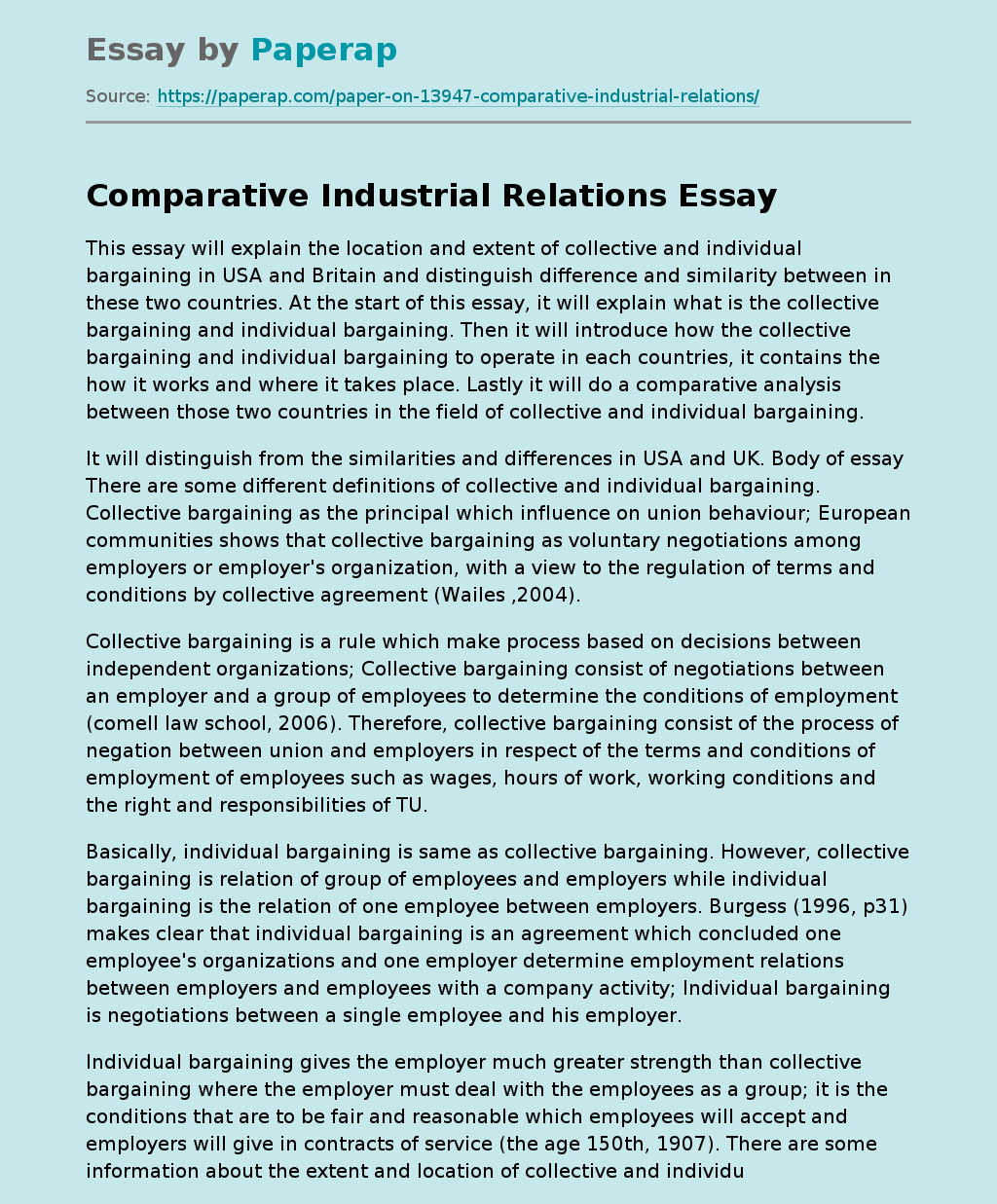Collective and Individual Bargaining in USA and Britain
European communities shows that collective bargaining as voluntary negotiations among employers or employer’s organization, with a view to the regulation of terms and conditions by collective agreement (Wailes ,2004). Collective bargaining is a rule which make process based on decisions between independent organizations; Collective bargaining consist of negotiations between an employer and a group of employees to determine the conditions of employment (comell law school, 2006). Therefore, collective bargaining consist of the process of negation between union and employers in respect of the terms and conditions of employment of employees such as wages, hours of work, working conditions and the right and responsibilities of TU.
Basically, individual bargaining is same as collective bargaining. However, collective bargaining is relation of group of employees and employers while individual bargaining is the relation of one employee between employers. Burgess (1996, p31) makes clear that individual bargaining is an agreement which concluded one employee’s organizations and one employer determine employment relations between employers and employees with a company activity; Individual bargaining is negotiations between a single employee and his employer.
Individual bargaining gives the employer much greater strength than collective bargaining where the employer must deal with the employees as a group; it is the conditions that are to be fair and reasonable which employees will accept and employers will give in contracts of service (the age 150th, 1907). There are some information about the extent and location of collective and individual bargaining in the UK. Burgess claims that the trade union in the UK is freedom association.
Employees have the right to join or not join a trade union and they have future right to take part in the activities of a union at an appropriate time. The UK has strongly rooted in workplace organization. The right of trade union is quite low and strike funds are usually small. Workplace representatives are off work at reasonable time, paid by the employer and to carry out their functions. Moreover, in the agreement there are only a few hours a week and this agreement is often informal (Burgess, 1996, p336).
Between the signatories collective agreement is not legally enforceable unless they expressly state. There are two levels of bargaining in the UK. One is local bargaining another is national bargaining. Visser (1996, pp67-69) points out that expect pay and hours the local bargaining was basically administrative and monitoring activity which compare to national agreement. In British much narrow scope of the national agreement while the local bargainers had more informal negotiations issues such as job demarcation and staff levels. In the UK the bargaining power of the workers was increased year by year.
On the other hand, the national agreement is minimum norms for wages and working hours, as well as the rule that concern procedures of conflict. They were more and more frequently supplemented by informal shopfloor negotiations between local managers and shop stewards. In the UK the pay determination has always been decentralized. In addition, some industrials keep national agreement on non-pay such as annual holiday entitlement or premium payments for shift work. As for white collar grades, under collective bargaining pay systems based wholly or partly in individual performance with the widespread adoption.
However, in public sector collective bargaining is much more entrenched (Burgess, 1996, pp350-359). The primary means of addressing American workers’ needs is through individual bargaining due to the decline of unions and the renewed focus on individual rights has led the United States Congress and state legislatures to rely increasingly on specific statutory rights. In contrast to other industrialized countries, two facets of the system of individual contract rights in the United States stand out as truly exceptional–the employment at-will doctrine and reliance in individual employment contracts for the provision of health insurance.
In the evolution of these doctrines, United States constitutional protections have played an important, but merely supporting role in establishing a strong legal environment for the presumption of freedom of contract. State and federal statutes have also played a largely supporting role in the development of both the employment-at-will doctrine and health insurance provisions providing either some specific prohibitions against discharge or prescribing certain forms and protections for employee health benefits if offered by the employer.
But its advantage and disadvantage of individual bargaining are obvious in the US. Individual bargaining can provide the most individualized solution of meeting the needs of the parties. It also enjoys relatively low administrative costs. Unfortunately, market failures and lack of bargaining power mean that individual bargaining often results in an impoverished solution for many workers that fails to address many of their basic needs.
Collective and Individual Bargaining in USA and Britain. (2018, Feb 05). Retrieved from https://paperap.com/paper-on-13947-comparative-industrial-relations/

